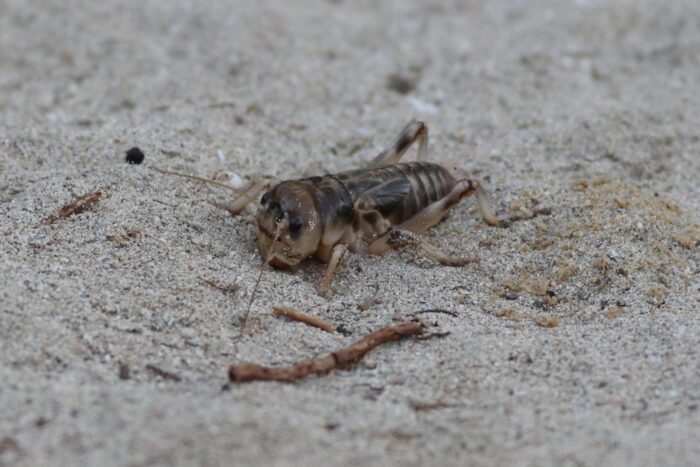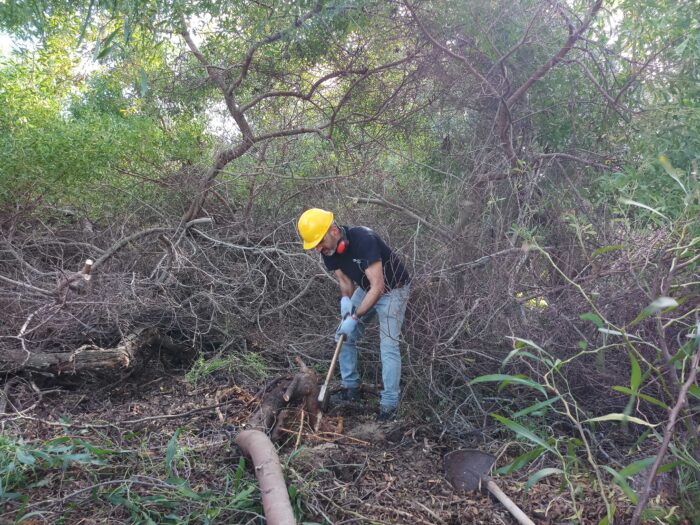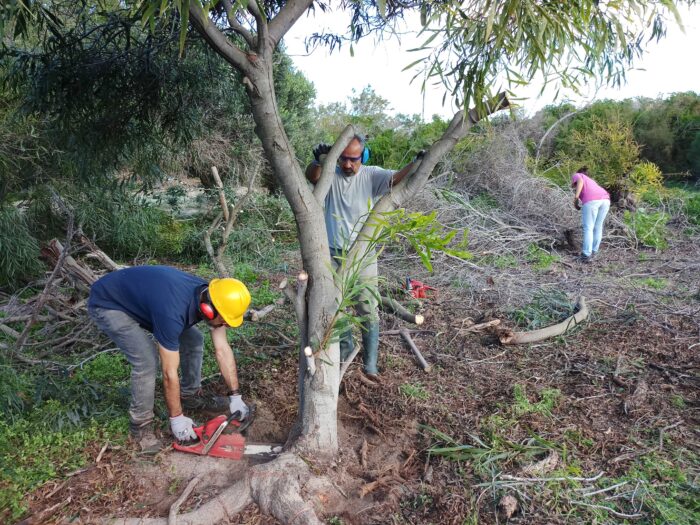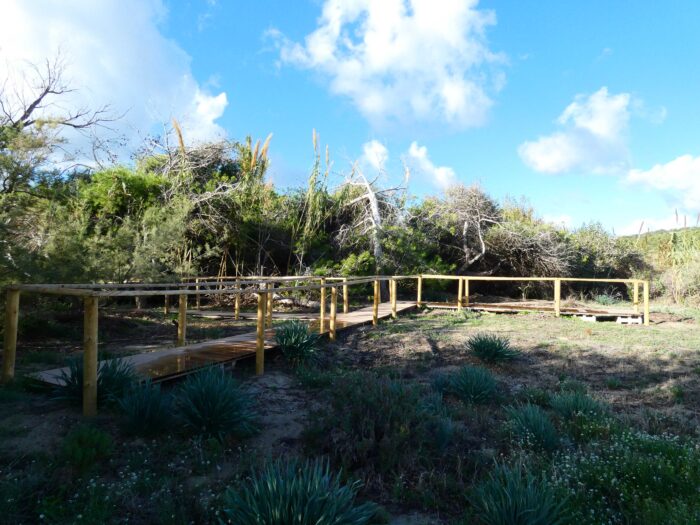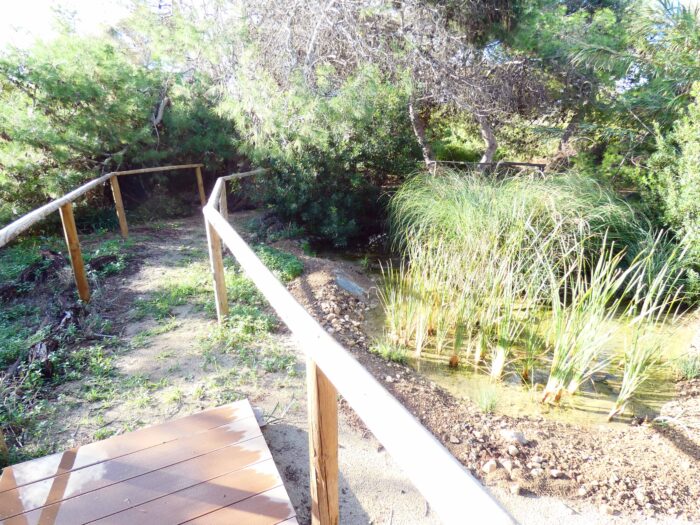The first image of Għadira Nature Reserve that often comes to mind is that of the brackish pool with small islands ideal for resting birds. We often overlook the fact that within the small area of the nature reserve various habitats are interwoven in a delicate mosaic – the brackish lagoon is fringed by halophytes and salt marsh vegetation; thickets of Sharp Rush and stands of Phragmites reeds grow densely in pockets of marshland and along the perimeter ditch, while yet another very distinct habitat which has recently been uncovered and restored is also to be found – the sand dunes.
Early years
The stretch on the seaward side of the nature reserve was historically a complex sand dune system with the various flora and fauna typical of this habitat including the Siculo-Maltese endemic Burrowing Sand Cricket (Brachytrupes megacephalus). However, come the 60s and 70s the use of cars increased heavily and the dunes being situated on the hinterland of the beach suffered severe degradation as they gave way to parking areas for both cars of beachgoers and the local buses, destroying a substantial area of sand dunes.
At that time afforestation projects in the various parts of the north of Malta (including Aħrax and Miżieb) were underway to green the rather barren landscape of the Maltese Islands. What was left of the Għadira bay sand dune area was earmarked for afforestation using the Blue-leaved Acacia (Acacia cyanophilla), a species which had been used to convert desert into fertile land in other countries such as Israel and Australia. The eventual widening of the main road leading to Marfa cut off the annual supply of fresh sand.
Għadira Nature Reserve was officially protected in 1979 when the management of the area was handed over to the Malta Ornithological Society (today BirdLife Malta) as an area of nature conservation and environmental education. The remnant sand dune area which covered approximately a total of 0.6 Ha (6,000 square metres) was still not part of the nature reserve back then and the focus was mainly on the engineering works to enhance the brackish pool habitat, including digging works to create a ditch and embankment surrounding the reserve; and the creation of shallow islands for providing foraging shorelines for migratory wader species. Works were done under the supervision of Mr. Charles Gauci, the first warden and environment teacher at the reserve and the late Mr. Herbert Ernest “Bert” Axell, a British naturalist and environmental engineer of international acclaim on the creation of various (Royal Society for the Protection of Birds) RSPB nature reserves.
The sand dune area was eventually annexed to the nature reserve in 1995, however its state was rather impoverished. Typical flora were still present in sparse patches with a thriving small population of the endangered Burrowing Sand Cricket. This cricket species requires clear stretches of sand and low vegetation to thrive, however the Acacia trees by now had changed the sand dune remnant with a thick matt of decomposing leaves and a whole network of root runners which were fast transforming the sand dune into a thick Acacia grove. Indigenous Aleppo Pines (Pinus halepensis)were also planted in part of the dune area to create a coastal grove ideal for migrant passerines within the reserve, but which further reduced areas of clear sand.
Habitat restoration needed
Restoration of the sand dune habitat has long been part of the Għadira Nature Reserve management plans as approved by MEPA and later ERA. Works were initiated by seeding and planting of various dune flora species such as Ambrosia marittima, Euphorbia terracina and Erygium marittimum in early 2010 in order to increase their population. This helped in establishing mother plants from which more seeds could be obtained at a later stage. However with the Acacia trees still growing strong and the organic matter layer they created reaching up to half a metre depth, there was no way that such flora and the vulnerable Burrowing Sand Cricket could possibly flourish.
Works on the removal of the Acacia trees started in 2016. Works were done avoiding the breeding seasons – spring and summer in case bird species like the Cetti’s Warbler and Sardinian Warblers would be breeding in the Acacia trees. At first few trees were removed from the central part followed by removal of the underneath leaf litter. The layer of organic matter unless immediately removed upon cutting down a tree acts as an ideal medium for various weed species including Stinging Nettles (Urtica spp.) and Annual Mercury (Mercurialis annua) which grow profusely in the nitrogen-rich compost. Sand dune flora stand no chance of competing with these weed species as these grow high and dense thus shading all vegetation surrounding them. The work was all done manually for minimal disturbance, using chainsaw for cutting the trees, hand-tools for removal of organic matter and wheel burrow for transporting the organic matter. Removal of the trees and underlying roots and humus continued for the next three years. Very often organising group activities was the most effective way to remove organic matter in bulk from the site.
The Farsons Foundation project – Conservation of the Burrowing Sand Cricket
Għadira Nature Reserve is one of only 22 sites in Europe designated for the protection of the Burrowing Sand Cricket, as protected under the EU Habitats Directive and the Bern Convention. The Burrowing Sand Cricket is a nocturnal cricket endemic to Malta and Sicily with a very restricted range. The species is mainly threatened from habitat loss by urbanisation as well as sports activities on sandy areas and intensive management practices of public coastal parks. The International Union for the Conservation of Nature (IUCN) lists the status of the Burrowing Sand Cricket as Vulnerable while the EU conservation status is Unfavourable-Bad, hence the importance of protecting such habitats.
In 2019 much-needed funding came from The Farsons Foundation to boost the sand dune restoration project and hasten the removal of the remaining Acacia trees and organic matter. A dumper was rented on a number of occasions to transport the organic matter to carefully selected sites within the reserve and to remove larger Acacia trunks and thick roots. These were utilised for creating islands of branches in the brackish lagoon for birds to rest on and as nesting sites. Most of the sand area within the dune area was finally uncovered.
In order to appreciate the sand dune habitat one must be able to visit the site without disturbing it, which can only be done by means of a board walk. The Farsons Foundation’s financial assistance was crucial for the construction of a board walk to access the dune both for public visitors and for school visits. The board walk is made of 100% recycled plastic slats and is ideal for visitors to observe the sand dune throughout the vegetative season without trampling on the vegetation.
Encouraging results
The first sand dune floral species showing a marked natural dispersal was the Coastal Viper’s Bugloss (Echium arenarium) which spread throughout the area in spring 2020 covering the ground with a carpet of tiny blue-purple flowers much appreciated by bees and other insect pollinators. Hoopoes (Upupa epops) were observed in the sand dune throughout March and April, at times up to eight birds were noted feeding on insects amongst the low vegetation.
The Burrowing Sand Cricket was very evident throughout the summer months of 2020 with more than 40 active burrows counted in mid-July within the area. New seedlings of Ambrosia marittima and Euphorbia terracina were also noted emerging by October. The restored sand dune will help to stabilise the Burrowing Sand Cricket population of the area both within the reserve and surrounding areas as well as the various other species typical of such a unique habitat.
By David Attard, Għadira Nature Reserve Managing Warden





